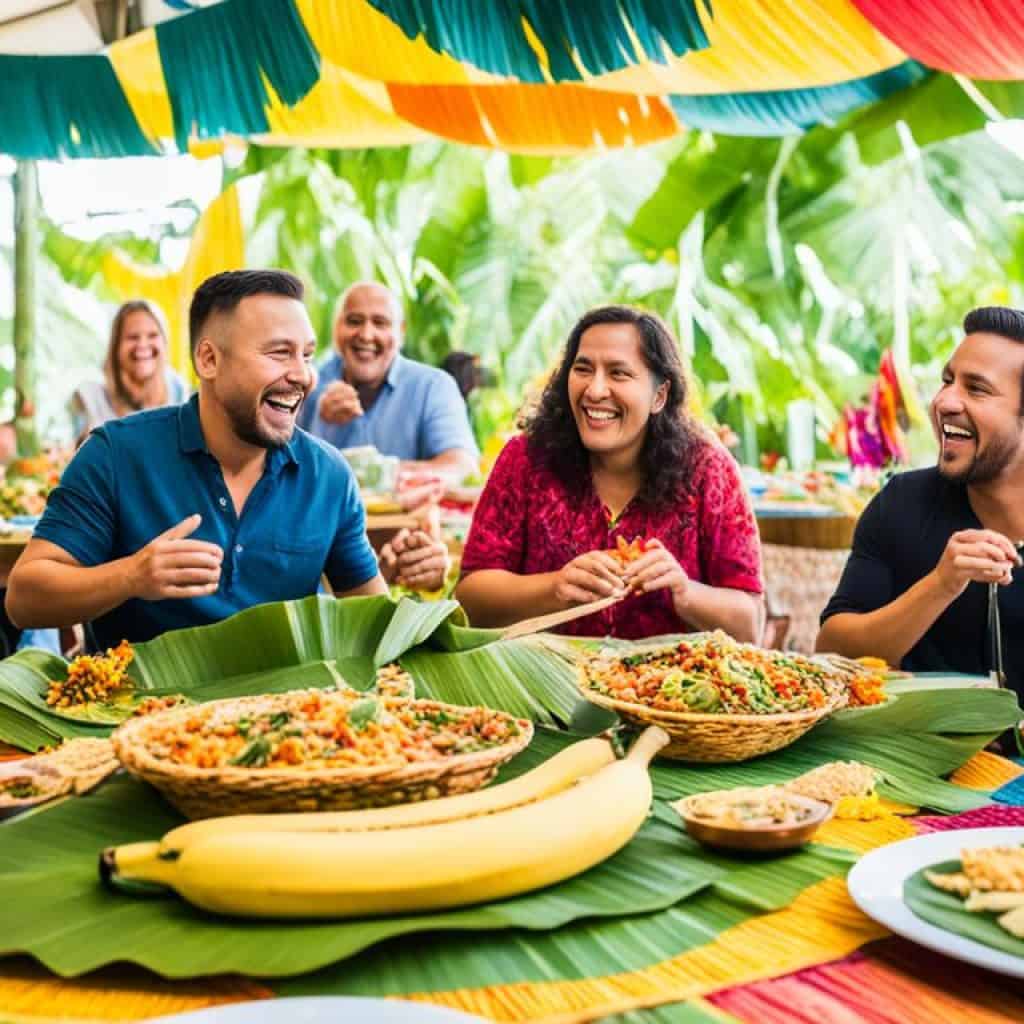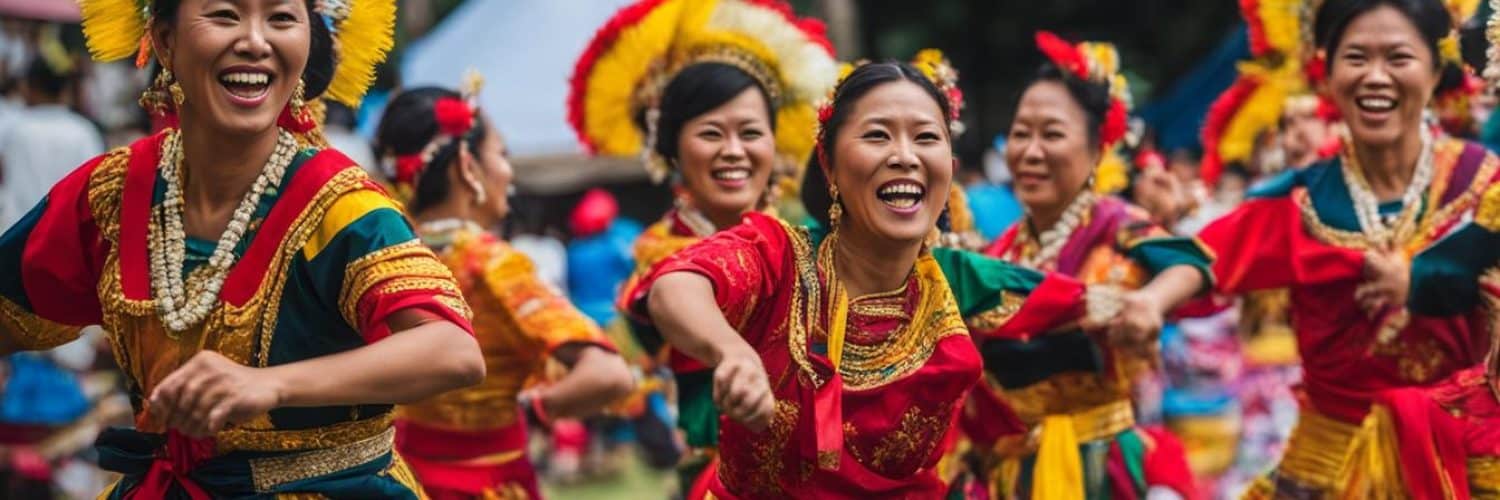Ever wondered about the Tagalog people’s vibrant culture and history? They’re the largest cultural-linguistic group in the Philippines. Their story is one of shaping Filipino society.
This journey reveals the Tagalog people’s resilient spirit and deep traditions. It also shows their dynamic link with foreign cultures. Let’s unravel this fascinating world together.
Get ready for a thrilling adventure. You’ll be amazed by the beauty and diversity of Filipino culture.
Key Takeaways:
- Explore the historical significance of the Tagalog people in shaping Filipino culture.
- Discover the unique traditions and customs that are cherished by the Tagalog community.
- Uncover the strong family bonds and sense of community that define Tagalog culture.
- Learn about the Tagalog people’s connection with foreign cultures throughout history.
- Understand the intertwining influence of East and West in Filipino culture.
The Tagalog People’s Connection with Foreign Cultures
For centuries, the Tagalog people have been pivotal in cultural exchanges. They’ve interacted with the Chinese, Spanish, and Americans. They’ve mixed various cultural aspects into their society. This blend has transformed the Philippines, aiding in its modern and Western evolution. The Tagalog people have, thus, nurtured a rich mix of traditions and food practices.
The Tagalog’s interaction with the Chinese is a notable example. Tagalog food, like pancit and lumpia, shows Chinese influences. They’ve also fused Chinese architectural elements into their buildings. This results in a unique landscape.
Spanish influence through Catholicism has deeply impacted the Tagalog people. Over 80% are Roman Catholic today. Religious traditions strongly influence their life.
“Through their encounters with foreign cultures, the Tagalog people have embraced diversity and adapted and shaped these influences to create a unique blend of traditions, food, and customs.”
The American era brought new ideas to the Tagalog people. English and the American education system have profoundly impacted them. American governance and infrastructure changes have also altered their lifestyle.
The Tagalog’s ongoing engagement with foreign cultures enriches their identity. Their cultural mix highlights their adaptability and openness. They proudly carry a blend of their roots and global influences.
Examples of Cultural Exchange with Foreign Cultures:
- The incorporation of Chinese culinary techniques and flavors into Tagalog cuisine, creating popular dishes like pancit and lumpia.
- The adoption of Spanish religious practices, with Roman Catholicism becoming the dominant faith among the Tagalog people.
- Importing American concepts and institutions, such as the English language and the American education system, which has had a profound impact on Tagalog society.
The Importance of Family in Tagalog Culture
Family holds a special place in Tagalog culture, with a focus on the extended family. Close friends are also seen as family. They all support each other, especially in hard times.
The family ties in Tagalog culture go deep. They often involve political and business connections. Families work together to reach common dreams.
Family events in Tagalog traditions are very important. These include birthdays and weddings. Everyone comes together to celebrate with joy and community spirit.
Family Values and Relationships
Respect and loyalty are key in Tagalog families. Parents are highly respected, and children learn to follow their elders. This ensures Tagalog traditions live on through generations.
“The family is our foundation, teaching us our values and customs. It shapes us as Tagalog people.” – Juan Dela Cruz, cultural anthropologist
Bayanihan: The Spirit of Community
The Tagalog people believe in bayanihan, or community spirit. In tough times, everyone helps out. This makes Tagalog communities strong and united.
Preserving Tagalog Traditions
Tagalog traditions are kept alive through the generations. This includes dances like the Tinikling and the art of weaving barong Tagalog shirts. Festivals like Pahiyas and Kalesa show the beauty of our customs.
| Tagalog Customs | Description |
|---|---|
| Pagmamano | A gesture of respect where younger people press an elder’s hand to their forehead. |
| Harana | A serenade by men to show love and admiration. |
| Bahay Kubo | A folk song listing fruits and vegetables in the Filipino diet. |
The role of family in Tagalog culture is profound. Family bonds keep traditions strong, share values, and build community. Celebrating these customs helps keep Tagalog culture vibrant and unique.
The Resilience of the Tagalog People
The Tagalog people are known for their amazing ability to bounce back. They face disasters with strong community bonds. They always help each other, expecting nothing in return.
This community spirit, called bayanihan, is a big part of their culture. It shows their strength and togetherness.
“When disaster strikes, the Tagalog people come together. They support and uplift each other. It’s truly inspiring to see their resilience and determination.”
– Maria Sanchez, Cultural Anthropologist
The Tagalog people stay positive, even in hard times. They are great at overcoming challenges with creative solutions.
This ability is rooted in their culture. They can rebuild and flourish after disasters, showing their resilience.
They support their neighbors through community initiatives and resourcefulness. Their spirit inspires unity and hope in their communities.
Bayanihan: The Spirit of Solidarity
Bayanihan means solidarity and unity. It’s central to the Tagalog people’s resilience. It comes from “bayani,” which means hero.
When there’s a calamity or need, Tagalog families come together. They offer their time, resources, and support to help others.
The Tagalog people have a strong community sense and resilience. They support each other, overcoming adversity. This makes them a vibrant part of Filipino society.

| Key Characteristics | Description |
|---|---|
| Unity and Community | The Tagalog people prioritize collective well-being and exhibit a strong sense of community, fostering resilience and support. |
| Resourcefulness | They approach challenges with creativity, finding innovative solutions and adapting to new circumstances. |
| Positive Outlook | The Tagalog people maintain a positive perspective, believing in their ability to overcome challenges and build a better future. |
| Bayanihan Spirit | The spirit of bayanihan serves as a driving force behind their resilience, fostering solidarity and unity during difficult times. |
The Religious Identity of the Tagalog People
Over 80% of Tagalog people follow religion closely. Most of them practice Roman Catholicism. This faith deeply influences their culture and spirit.
Sundays are very special to them. They go to church as a family, join in the mass, and find spiritual peace. Their religious roots run deep, affecting daily life profoundly.
Respecting elders is key in their culture. They show it through words and actions. One beautiful act is Pagmamano, where they lift an elder’s hand to their forehead. This shows respect and thanks. It highlights their respect for family and long-standing traditions.
“Our faith unites us and strengthens our sense of community. We gather as one, in prayer and celebration, as we strive to carry forward the teachings of our Catholic heritage.”
– Maria Santos, a Tagalog community leader
Their Catholic faith is central to the Tagalog identity. It impacts their values, ethics, and customs. It also plays a big role in how they interact and live, showing religion’s big influence on Filipino life.
Festivals Celebrating Religious Traditions
| Festival | Location | Date |
|---|---|---|
| Sinulog Festival | Cebu City | Third Sunday of January |
| Pahiyas Festival | Lucban, Quezon | May 15th |
| Ati-Atihan Festival | Kalibo, Aklan | Third Sunday of January |
| Penafrancia Festival | Naga City | Second to Third Saturday of September |
These festivals show the strong religious beliefs of the Tagalog people. They celebrate with joy, color, and devotion. Together, they honor their faith and traditions vividly.
Traditions and Festivals of the Tagalog People
The Tagalog people cherish their cultural traditions. They celebrate these through numerous festivals every year. These events showcase their customs, beliefs, and talents.
MassKara Festival
The MassKara Festival is a vibrant event in the Philippines, happening in Bacolod. It symbolizes the resilience and optimism of the Filipinos. The festival includes street dances, beauty pageants, and food fairs, with masks that dazzle everyone.
Moriones Festival
The Moriones Festival is celebrated in Marinduque during Holy Week. It tells the story of Saint Longinus, who pierced Jesus Christ’s side. People wear colorful masks and costumes to perform dances, reminding us of faith and sacrifice.
Christmas Celebrations
Christmas is very special to the Tagalog people. Celebrations start in September and can go into January. Families gather, exchange gifts, and enjoy traditional foods.
The Role of Food
Food brings everyone together during Tagalog celebrations. Favorites include lechon, adobo, and kakanin. Sharing these dishes strengthens unity and respects their culinary traditions.
Preserving Tagalog Traditions
“Through these festivals and celebrations, the Tagalog people demonstrate their unwavering commitment to preserving their heritage and passing down their traditions to future generations.”
Tagalog festivals and traditions are not only stunning but also meaningful. Participating in them helps people understand Tagalog heritage and the importance of keeping culture alive.
The Love for Music and Arts in Tagalog Culture
The Tagalog people truly cherish music and arts, making these essential to their lively culture. Music is especially dear, connecting people and uniting friends and families. Karaoke is a beloved activity, where folks sing, laugh, and have a great time.
Their passion for the arts isn’t just about music. Tagalogs also admire art and architecture. Their buildings reflect their creativity, blending traditional and modern styles beautifully.

Artists like Rody Herrera express the Tagalog spirit in their creations. Their art showcases the Philippines’ rich culture and diversity. Through various artistic forms, these artists help celebrate and preserve the Tagalog legacy.
The Influence of East and West in Filipino Culture
Filipino culture is a captivating mix from both the East and West. Throughout history, various interactions have shaped it. Chinese traders, Spanish conquerors, and American rulers have all left their mark. This mix has deeply influenced Filipino traditions, customs, and life.
Filipinos have a rich Asian heritage. This comes from their native roots and the values passed down through generations. But, they also show traits seen in Latin cultures. This mix of influences makes Filipino culture unique and exciting.
East and West impacts are visible in Filipino culture in many ways. Take Filipino cuisine as an example. It mixes ingredients and cooking styles from different backgrounds. This mix creates a unique and tasty food experience. Chinese and Spanish flavors come together in these dishes.
“Filipino culture is a beautiful tapestry woven with threads of resilience, adaptability, and a deep appreciation for diversity.”
East and West also influence Filipino language and how people communicate. The Filipino language mainly uses Tagalog. It also has words from Spanish, English, and regional dialects. This shows the historical interactions that have formed the Filipino identity.
Filipinos love music and the arts, reflecting East and West influences. Their traditional music has local tunes and rhythms but also takes from Western music. Filipino visual arts combine indigenous styles and Spanish colonial influences.
Filipino culture shows a smooth integration of East and West. It celebrates diversity, resilience, and adaptability. The history and culture exchanges have created a society that values its past but is open to new ideas. Exploring Filipino culture is like seeing a world where tradition and innovation blend, making a colorful and evolving tapestry of experiences.
Tagalog Culture and Hospitality
The Tagalog people are known for being warm and welcoming, especially to Western visitors. When you visit the Philippines, their genuine hospitality will make you feel like you’re part of their family.
Pakikisama is a key cultural practice among the Tagalog. This means getting along with others and keeping peace in relationships. It highlights their wish for smooth interactions and community feelings.
Another key part of their culture is utang na loob, or the debt of gratitude. It’s about repaying favors and showing thanks. The Tagalog focus on positive relationships and expressing gratitude for kindness received.
Tagalo culture is all about real connections and strong bonds in the filipino community. Their hospitality, desire for harmony, and gratitude make them welcoming and inclusive.
Getting to know their hospitality and culture will make your Philippines visit unforgettable.
Tourism in the Philippines
The Philippines is a beautiful spot for travelers. It has stunning natural sights, rich culture, and friendly people. You’ll find amazing mountains, beaches, caves, and markets here.
Looking for a place to stay? The Philippines has options for every budget. From cozy hostels to luxury resorts, you’re covered. Everyone is dedicated to making your visit unforgettable.
Experiencing Filipino culture is a major highlight. The country celebrates a variety of festivals. From Cebu’s Sinulog Festival to Baguio’s Panagbenga Festival, you’ll see the country’s vibrant traditions.
“The Philippines lets you dive into its culture and history. You can explore Manila’s Intramuros or try traditional Philippine dances. Each moment teaches you about the country’s past.” – Travel Expert, Maria Santos
Before you go, check the visa requirements. Your nationality and stay length affect what you need. Remember, there might be extra costs like departure taxes for your trip.
| Destination | Attractions |
|---|---|
| Batanes | Rolling hills, cliffs, and traditional stone houses |
| Palawan | Stunning beaches, crystal-clear waters, and the Underground River |
| Boracay | White sand beaches, water sports, and vibrant nightlife |
| Bohol | Tarsiers, Chocolate Hills, and pristine dive spots |
Exploring the Philippines is an unforgettable adventure. It’s a place where you can enjoy nature, culture, and make memories. No matter what you’re looking for, the Philippines will amaze you.
The Future of Travel in the Philippines
The Filipino people are focusing more on responsible and meaningful travel. This shift is creating new connections between locals and travelers from afar. Tourism in the Philippines is booming, drawing visitors globally who want to experience its rich culture and lively heritage.
An organization leading this shift is
Culture Trip
. They offer small-group trips that celebrate Filipino culture and traditions. These trips allow travelers to see beyond common attractions. They connect deeply with local Tagalog people and their lifestyle.
These trips aim to give travelers a true and unforgettable experience. They also focus on reducing the impact on the environment. More Filipino communities are now working to conserve nature and support responsible tourism.
Visiting the Philippines lets travelers help local communities, dive into the Filipino culture, and enjoy the Tagalog people’s hospitality. With stunning beaches, lush mountains, and rich history, the Philippines has something for everyone.
| Benefits of Traveling in the Philippines | Challenges of Traveling in the Philippines |
|---|---|
|
The future of travel in the Philippines is bright as travelers seek real and heartfelt experiences. The rich culture and hospitality of the Tagalog people are central to these experiences. By choosing responsible travel and supporting local communities, travelers help preserve and celebrate the Filipino culture for future generations.
References
- “Culture Trip – Philippines Tours and Trips 2021/2022” – theculturetrip.com
- “Sustainable Tourism in the Philippines” – tourradar.com
Conclusion
The Tagalog people are the largest cultural-linguistic group in the Philippines. They play a key role in shaping Filipino culture and identity. Their resilience and strong family ties contribute to the Philippines’ rich heritage.
Through centuries, the Tagalog people interacted with various cultures. This includes the Chinese, Spanish, and Americans. They have adapted these influences, leading to the country’s modernization.
The Tagalog people are known for their warm hospitality. They make visitors feel like part of the family. Their love for music and arts is shown in festivals and celebrations.
Looking towards the future of travel in the Philippines, we should embrace experiences that honor the Tagalog people. This includes their culture and heritage. By doing so, we celebrate the diversity and beauty of the Philippines.







Add comment